With the close season rapidly approaching I felt it was time to write the third, and final, instalment of my mini-series exploring the techniques and methods of extracting the cautious and sometimes elusive chub from Suffolk’s rivers.
Whilst the techniques I have deployed on my local rivers are by no means less effective on other rivers my approach and confidence is based on an intimate knowledge gained over what is now in excess of two decades on three very special rivers. When visiting other venues it is quite disarming approaching apparently featureless stretches of water trying to interpret the unseen topography that lies beneath the surface.
With care creases can be explored in addition to the more obvious features that stick out like a sore thumb – however these do, of course, receive so much regular attention by hoards of other visiting specialist anglers. If lucky, on a windless day with flow, it may be possible to identify areas of smooth flow perhaps alluding to a depression but without that necessary inside knowledge it is still a stab in the dark!
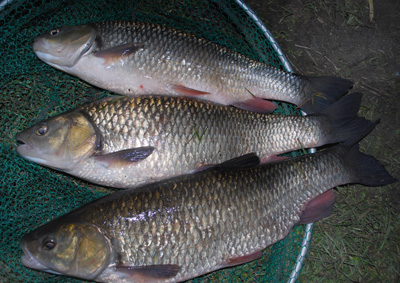 Of course if you are lucky to arrive and find a river in perfect trim with a rising temperature it is possible to have chub stumbling over themselves to become acquainted with the bank irrespective of pinpoint location; but due to the necessary arrangements for distant trips I am very much at the mercy of the conditions and have to take as I find.
Of course if you are lucky to arrive and find a river in perfect trim with a rising temperature it is possible to have chub stumbling over themselves to become acquainted with the bank irrespective of pinpoint location; but due to the necessary arrangements for distant trips I am very much at the mercy of the conditions and have to take as I find.
This made me reflect on what actually makes certain areas more attractive to chub and how these can be identified:
Seasonal chub movements.
In many respects fish location in winter is actually made easier as chub are usually resident in swims that seem to obviously provide the essential ingredients to live a safe and easy life; but this is only part of the story as there are other factors that work against both the fish and the angler. Initially, let’s take a look at why chub need to move in the first place. In summer the streamier shallows offer lush weed growth both rich in food, oxygenated water and adequate cover to avoid predators.
Summer chub do not haunt these areas exclusively; but even on deeper stretches chub appear to inhabit the upper levels of water, perhaps poised to intercept potentially nutritious items floating overhead. I am quite happy to exploit this characteristic by floating down bread or crusts and taking these fish off the surface!
As the nights draw in and the first frosts arrive the weed in the shallowest parts of the river die back first, pushing the fish towards deeper, safer areas of the river. But there are exceptions to this generalisation – certain features tend to hold fish irrespective of the time of year. These features could either be a raft, bank-side root system, or a depression in an otherwise shallow stretch of river. Chub favour this type of feature much to the extent that I have often been tempted to wade and artificially introduce such a feature with a minor excavation.
Whilst the majority of chub seem to follow a strong shoal instinct, for lots of reasons, there are significant advantages for chub to seek a more solitary existence avoiding the hoi polloi existence shared by their fellow brethren; principally less competition for food, less attention from predators and ultimately less angling pressure. Perhaps this is the reason why deeper stretches, apparently devoid of features, can throw up the biggest fish. So how can it be possible to narrow the odds in our favour?
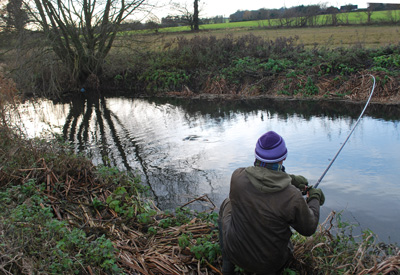 Watercraft.
Watercraft.
Raft swims: Due to the shoaling instinct of fish and the need to evade airborne predation, tree canopies and rafts encourage fish to gain collective sanctuary. But unfortunately, due to the ill thought out reintroduction of otters, chub now face a pincer movement from a far deadlier apex predator – especially for larger individuals! In localised areas, I have witnessed otters working a raft – and for many weeks – it has yet to return to fishing form, either rightly or wrongly assuming chub avoid that area for some time after.
Having previously covered an effective approach to fishing raft swims (Winter Chubbing article), it is difficult to elaborate other than to suggest that whilst a worthwhile feature, it is best to separate the shoal and for reasons described they can either seem to be full of fish or never seem to deliver.
I tend to fish undercut banks and holding spots where the river has scoured away an undercut within the root system of the tree in a similar style – even relatively small features can hold good numbers of fish. The best thing about this type of feature is that these areas tend to hold fish all year round unless pushed out during a heavy flood or predation!
Crease swims: Tony Miles describes the changes in current speed between fast flowing water and slower flowing water as a crease. Creases may occur where the main flow of the river hits an obstacle, either in the form of a mid river reed bed, a raft or inside of a bend. I like to think of these areas as potential conveyor belts; the faster water carrying food items in the flow, the chub lazily hanging on the slacker edges ready to skip into the faster flow to intercept passing food items.
Fishing the Yorkshire Swale earlier this season, I found fishing creases was incredibly effective and illustrated how drastic the change of pace can be between the fast and slacker water. The river the day before was tea stained, having risen 4ft in spate, and a disparaging conversation with a tackle shop owner suggested 2oz of lead would be needed to hold bottom!
The winning tactic on the day was, in fact, to cast out a bait to the far bank with two Swan Shot and bounce it across until it fell into the slack edge of the crease created on the inside of a bend. Bites would reliably wrap around as the bait settled in the slack resulting in chub to 4lb 9oz and the loss of a good barbel (gutted) but still not bad for a ‘tourist’!
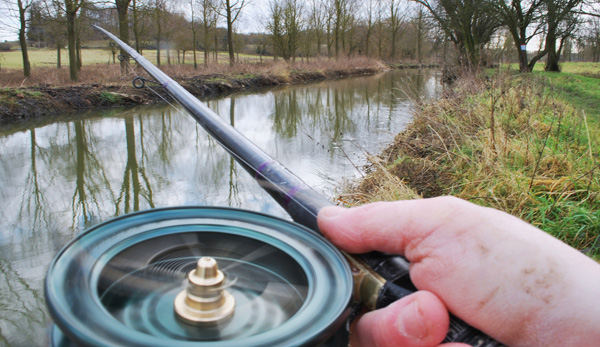
Featureless stretches: Perhaps the hardest feature of all to define but by examining the fact that at quick glance there appears little benefit for chub to frequent such an area it helps to imagine what would make such an area attractive from a big fish perspective.
Suffolk Rivers rarely exceed 7 or 8ft in depth, indeed any section over 5ft represents a deeper stretch. By carefully plumbing there is much to be gained from identifying even the smallest changes in river bed topography.
Depressions may be alluded to by an area of smooth water as the water passes above but flows are rarely sufficient to identify features by this trait alone. Mapping areas either by wading or by float and plummet can pay dividends; when flow rates increase even small depressions offer sanctuary during spate or flood and certainly attract food.
It is also beneficial to identify sharp changes in depth from shallow to deep water. Of course it is impractical to map an entire river environment but I tend to focus my attention on a particular section. It is amazing how quickly it is possible to build a mental picture of hidden river bed features.
On reflection, I regret calling any area on a river featureless, as surely the most obvious feature is in fact the near and far banks. When targeting these ‘featureless’ areas I take great comfort in the knowledge that chub simply adore the cover offered by bank-side reeds and rate these areas very highly. In fact, on close examination, a reed lined bank inevitably creates one great long feature as dead and broken reeds form a canopy, perhaps a foot wide in places that definitely encourage chub to hug tightly against the bank.
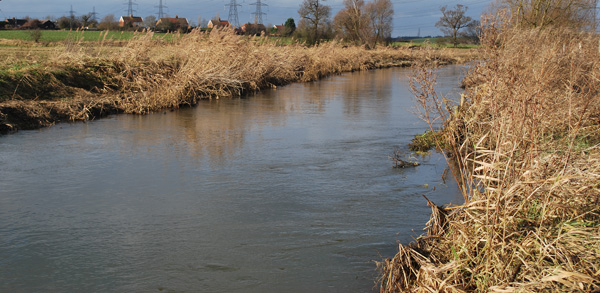
I believe there are additional benefits that ensure these areas are particularly attractive at certain times of the season. Fish expend far less energy when tight against the bank as inevitably friction slows the current sufficiently as it passes the reeds. Additionally, fish can sense even the slightest variation in temperature. I am certain that sunlight falling on a dark brown canopy must absorb some heat energy from even a wintery sun sitting low in the horizon creating an area slightly warmer than offered within the main flow. There – slacker water, warmth and a roof over their heads!!!
Other areas worthy of note include small protrusions of dead or dying weed beds, reeds or bushes, perhaps even an area where blackberry bushes discourage bank-side disturbance. All these may encourage a chub at some point and are worthy of attention.
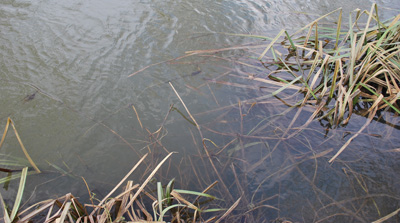 Creating artificial hot spots: It is possible to create artificial hot spots through pre-baiting. I am fortunate in that I visit one of the rivers I fish three or four times a week whilst walking the dog either before or after work. As I walk past prospective chub features I often introduce a few handfuls of mash and hemp – along with a few choice hook bait samples. This still requires thought and regard to features that chub may find attractive.
Creating artificial hot spots: It is possible to create artificial hot spots through pre-baiting. I am fortunate in that I visit one of the rivers I fish three or four times a week whilst walking the dog either before or after work. As I walk past prospective chub features I often introduce a few handfuls of mash and hemp – along with a few choice hook bait samples. This still requires thought and regard to features that chub may find attractive.
Fishing to features: As a rule of thumb, when the river is running clear it is best to cast tight to features. For example, a cast within inches of the bank, or tight against a snag is more likely to be taken. A few inches off – and it is unlikely to get a touch. This situation definitely changes in times of fining down after a flood. Coloured water and the additional burden of fighting against a flow will encourage fish to find what they can, where they can.
Likewise at night, chub are more likely to explore their environment under cover of darkness and perhaps, if conditions have been stable, are pretty catchable.
I will add here, a truly searching method of covering large amounts of water is to long trot with bread flake. This is a method that, given a good flow, has accounted for a number of chub over the five pound mark for me – a good benchmark for this type of venue. Better still, you are taking the bait to the chub in a manor no self respecting chevin will deny itself and you can cover literally miles of river in a day!
Inducing bites: A superb technique for searching swims is to twitch baits along the bottom. This is particularly effective on those days when you need to present the bait on a chub’s nose if they are unwilling to move. It works best on an upstream presentation, perhaps up against the far bank.
After casting and allowing the bait to settle, I attach a bobbin to signal either a pull or a drop back. When a decision is made to twitch the bait, I reel the bobbin to the rod and then pull it down to dislodge the bait. After allowing it to settle once again I reposition the bobbin to indicate any signs of interest. It is surprising how often a bite comes almost as soon as the bobbin has been repositioned and with care it is possible to trip a bait along the far bank in a really effective and efficient manner.
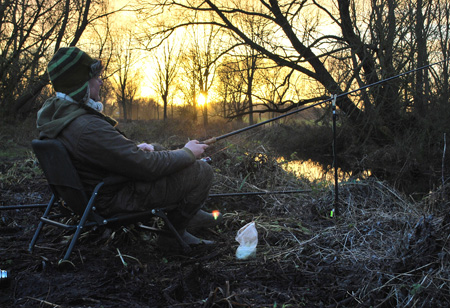 Bait and bait application.
Bait and bait application.
For some reason bread, luncheon meat and cheesepaste have an almost legendary fish pulling reputation and I am very confident to use these most basic of baits – but I justify this statement by adding their effectiveness can be further enhanced with due care and attention to their carefully controlled application.
Whilst arguably, plain cheesepaste and luncheon meat will still continue to catch, chub wise up pretty quickly and learn to associate these items with danger. In fact there have been occasions where, on visiting swims a few days after fishing, I’ve noticed that cheesepaste has remained uneaten, and obviously avoided, on the river bed.
The science behind why a fish should wish to avoid an item it associates with danger is well understood and can be explained by applying Pavlov’s experiments with dogs and feeding stimuli to a parallel situation. Observing a dog’s behaviour on the introduction of food, Pavlov noted that dogs would salivate; until this point, it was simply considered that dogs did this in response to the food.
Pavlov added an additional stimulus in the form of a bell, introducing both the food and the ringing bell at exactly the same time. After a period of time, Pavlov introduced the ringing of the bell with no food and was astounded to note that the dog would salivate on the introduction of the ringing bell stimulus…The dog had learnt by association to expect food when the bell rang!
It almost makes perfect sense that if a cautious creature like a chub picks up any attractive food item, is then dragged around its environment, removed from its habitat, and then returned, it is going to associate a perfectly edible food item with danger and avoid it!
Perhaps this is only partially true, due to the fact that with pre-baiting, it is possible that the chub has had enough positive experiences to consider it as a viable food item – for a time. This is certainly why the particle approach remains an incredibly effective method when applied carefully; baits such as hemp, caster maggot, and to some extent pellets, must provide a near infinite number of positive experiences in ratio to actually picking up a piece which is ‘armed and dangerous’.
Realistically, it is the destiny of any large bait item to become less effective with time; this is why it is important to pay particular attention to a bait’s application and why there is a benefit in using a bait with a unique signature (or label) in terms of making it different from anything anyone else may be using.
Flavouring baits: It is possible to give your bait a unique signature by either adding a flavour, or perhaps even a change of colour. Adding a spice (e.g. cloves, fennel, cumin etc), squeezy tube garlic, scopex and even liver and garlic sausage flavours to cheesepaste is very effective. Luncheon meat accepts flavours very readily and could be either a curry powder, Oxo cube granules or any number of meaty or fishy liquid flavours.
I have a preference for natural type flavours over synthetic flavours as it is nearly impossible to overdose or overload the flavour. The world truly is you lobster regarding the invention of bait combinations and flavours and is actually quite good fun!
I don’t tend to muck about with bread too much as I have felt it pretty un-necessary. Perhaps a change to brown bread can reap rewards but typically I think bread has similar properties to a particle bait and has rarely blown in my experience of using it.
Application: The aim of pre-baiting is to introduce a bait over a period of time until chub accept it as a safe food item and take it readily – in other words giving the fish lots of positive experiences. This is why I like to settle on a chosen flavour and introduce it over a period of time. I usually do this as a cross over, introducing the ‘new’ bait whilst still fishing with the established bait so that when I change to the new bait it is already accepted. Perhaps if I am lucky, I confidently fish a bait with a particular ‘signature’ flavour for upwards of two seasons before considering a switch.
I don’t think it is necessary for every chub to have had a ‘good’ experience on a bait for it to be effective, especially in well known hotspots. By and large chub are competing against each other for a very limited amount of resources – especially at the traditional back-end of the season when they start to pack on weight and need to gain condition for spawning quickly.
Part of the advantage of shoal life is that individuals almost seem to share a collective conscience and are more than happy to learn from each other’s mistakes. It is fascinating watching their reaction to a bait during the close season. If it is something considered safe it is almost invariably engulfed instantly; offer them something ‘dangerous’ and the mood and posture of the whole shoal changes. Now I am certain not every individual has had a bad experience on a particular ‘blown’ bait but fear and apprehension is transmitted to other individuals and they will not touch it!
Signing off!
This final piece has been far more technical than I intended. I have omitted to describe rigs in detail in this part as they have been extensively covered in my previous instalment (Winter Chubbing) though this is a far too elaborate a statement preferring, as I do, to fish 10lb mono straight through to the hook with balanced lead direct to nylon for 90% of my winter ledgering. It is simple but it continues to work effectively and kind of illustrates my approach.
Had I written this article ten years ago I may have been extolling the virtues of soft braided hook links, link ledgers, running ledgers, beads, buttons, swivels who knows what…
The fascinating thing about fishing is that it is very much a journey of discovery. I know a lot of what I have written, though based on experience and observation, is grounded on supposition based on my interpretation of the situation as I have seen it at the time and is open to change and will evolve in time.
I am deeply indebted to the work of late, great Peter Stone, Tony Miles, John Wilson, Matt Hayes (for sheer enthusiasm alone!) and the Chub Study Group – they have all coloured my approach through either their written work or fellowship (CSG, especially Robin Wallis) and contributed to much of what has been written here one way or another. I don’t know how this piece will stand against even my own opinion in time to come. One thing for certain, it is bound to change!










